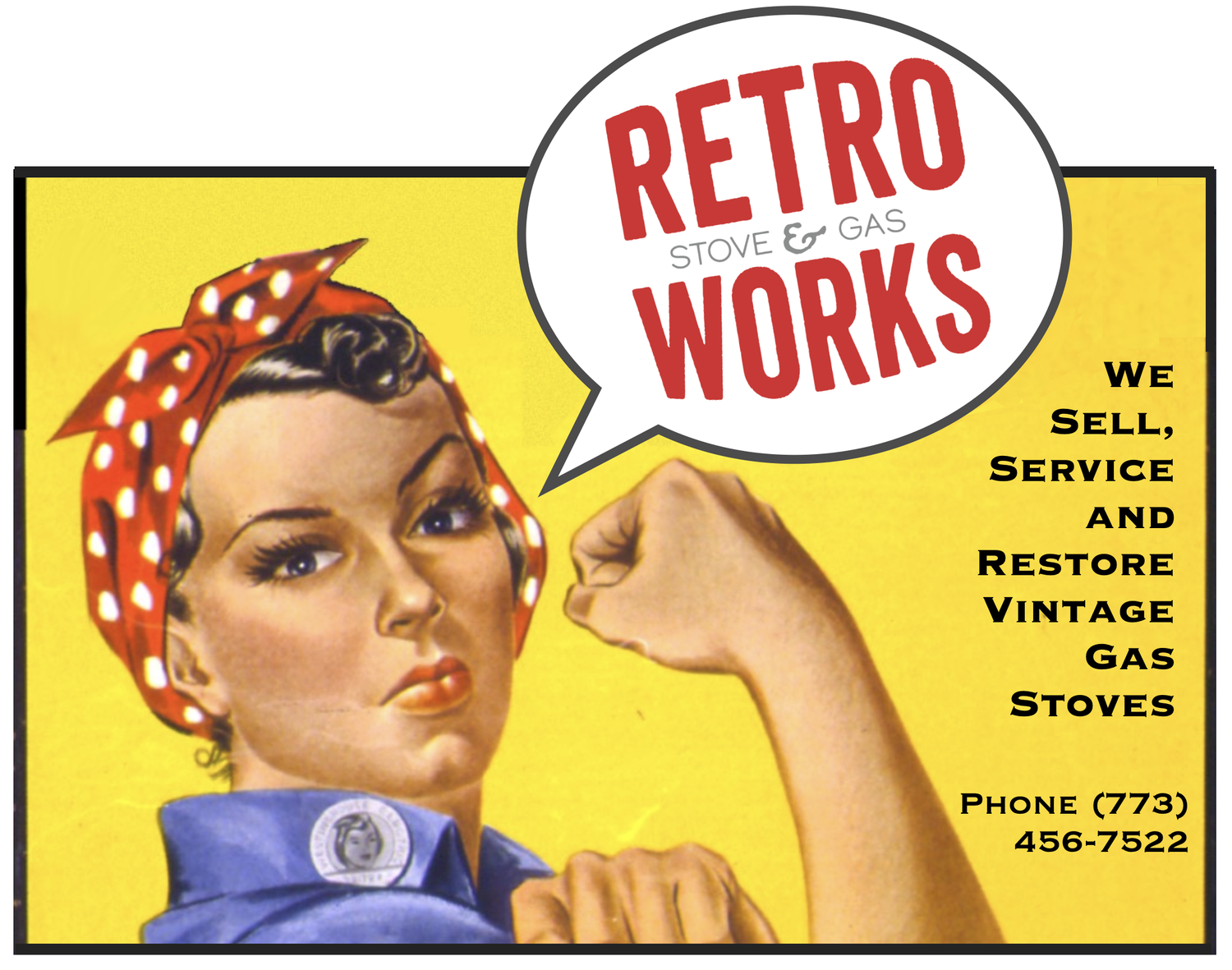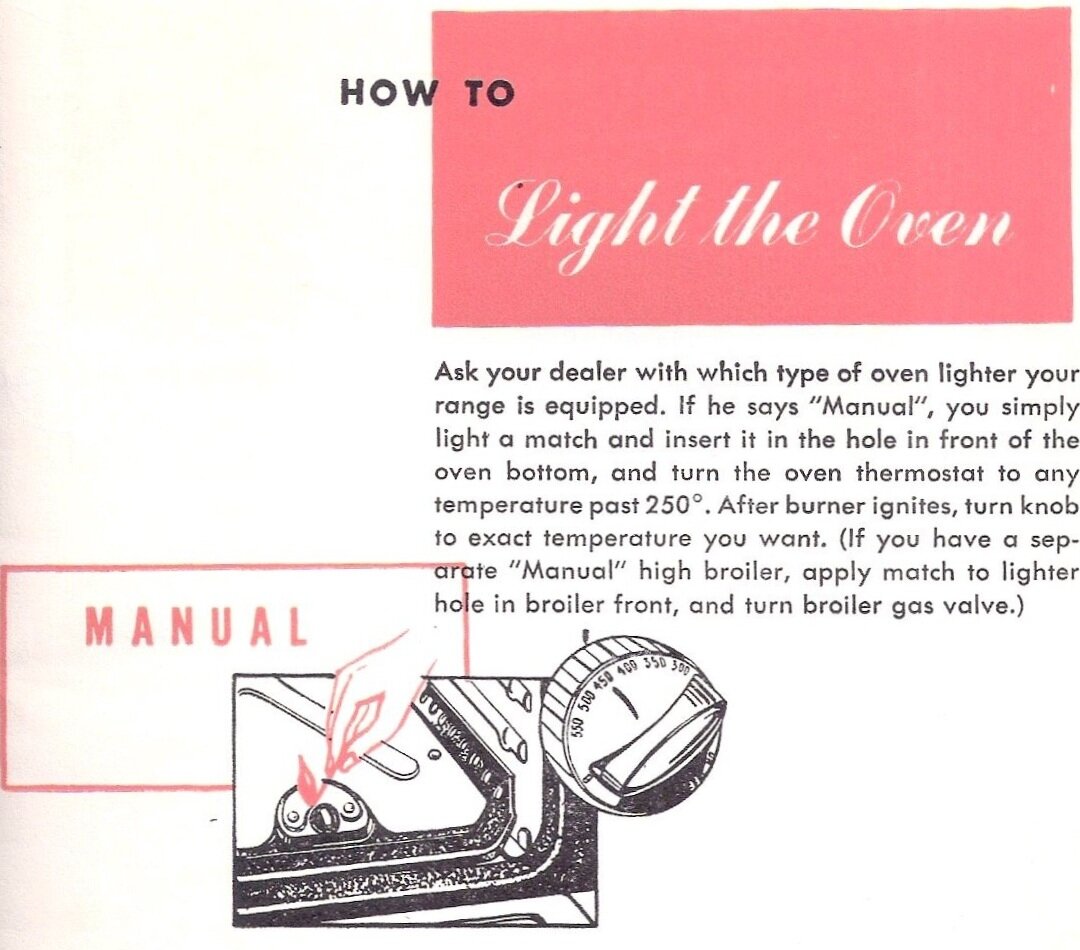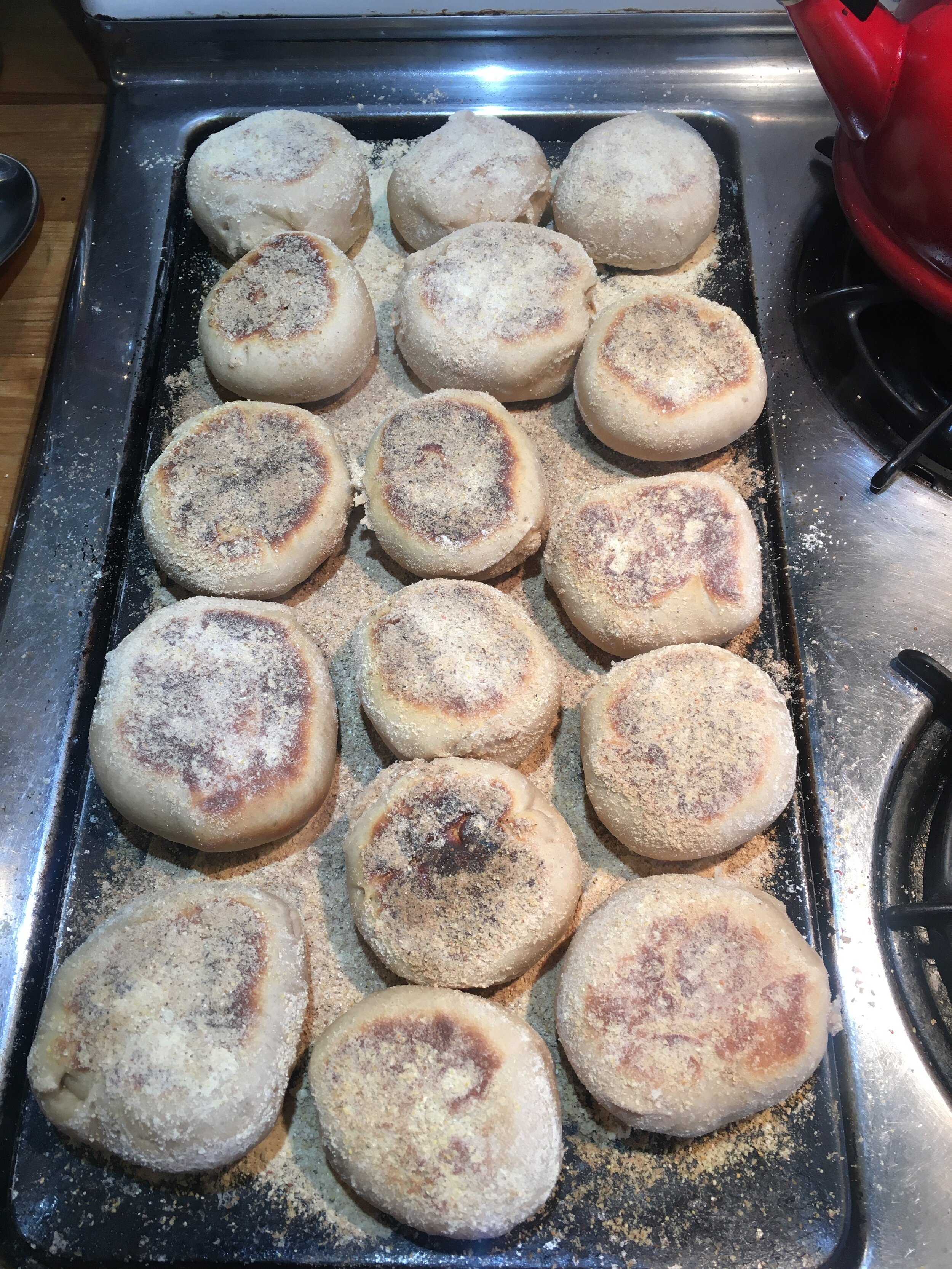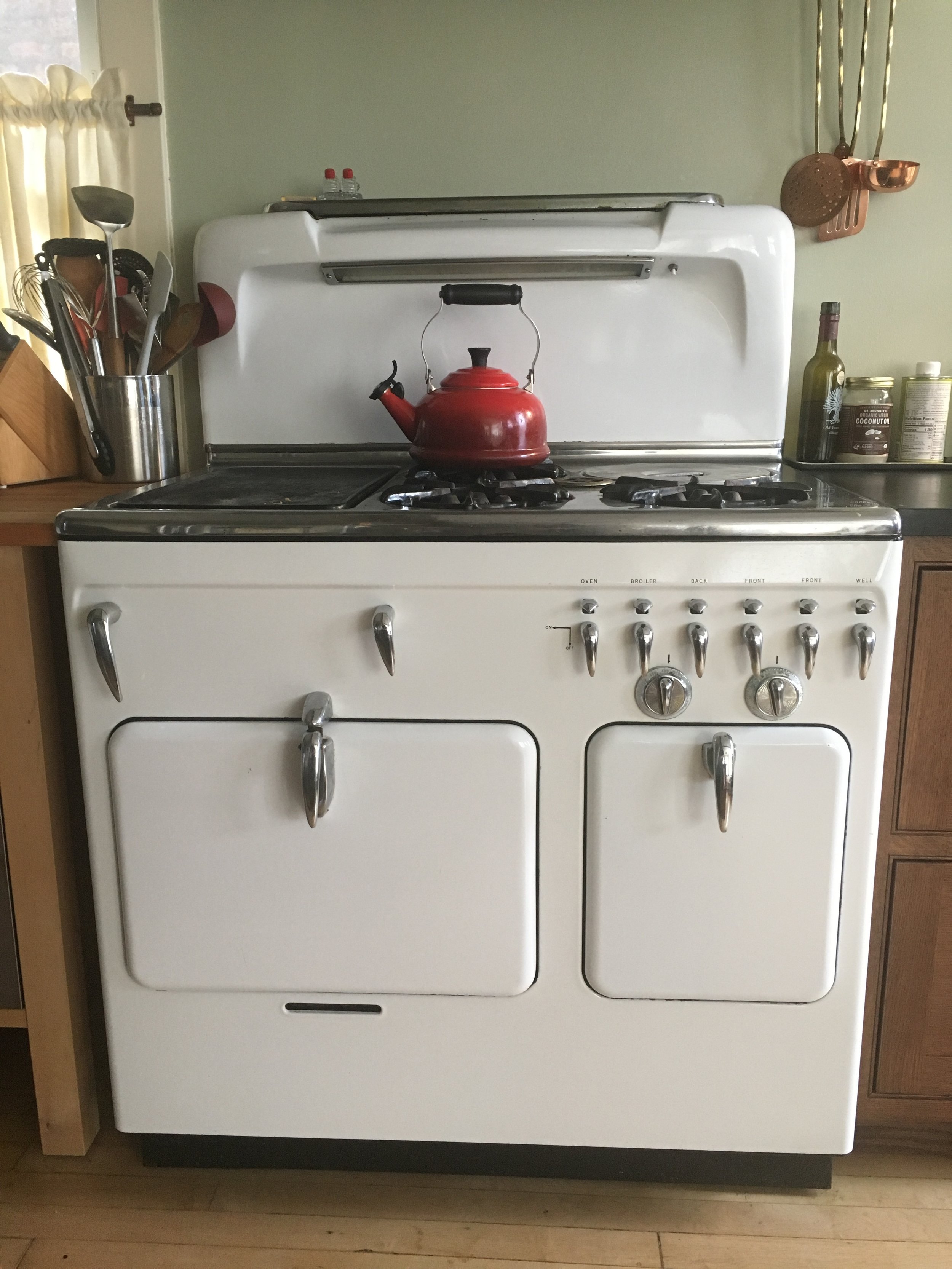Her oven had suddenly started burning the family's meals: right before Christmas. After running her through the gauntlet of questions, there was little room for doubt: her oven temp went through the roof no matter what setting. I was already booked for the entire week before Christmas, and she agreed to pay the premium price for after-hours service.
Now began the hunt: hopefully we had a loose identical or compatible rebuilt or used T-stat in stock. Nope. Okay, hopefully we had a stove in the shop with a T-stat that might work. A late 50's Kenmore looked surprisingly good. "Surprisingly", considering that the client's stove was so different in era and brand. So the shop guys and I pulled the stove from its spot, prepped it for operation (they are typically semi-disassembled and need to be fitted with new connectors), and fired it up. It took awhile but I was able to get the thermostat's various functions into calibration. Fantastic: we now had a used thermostat to pull for the job that I knew worked and was already spot on.
But in having a final look at my client's photos, I realized I couldn't fully see the connection behind the T-stat body to the oven's gas tube. When she sent better photos, it became sickeningly clear that the Kenmore's connection was not in fact compatible. All that time with the Kenmore - wasted.
Next strategy: check out all the other stoves in our off-campus storage. Fortunately we photo archive any stove we acquire so that we can "remotely" inspect their components on the computer, and of course the most likely prospect was our oldest Roper, a dual oven: it was still of a more recent vintage than our client's Roper, but its T-stats looked practically identical, including the proper connection. The twin ovens were a plus: since we had already spent so much time on the project, we didn't want to drag this stove to the shop in order to set it up and test the T-stats, so we'd yank both T-stats to bring to the job, and have a good chance of one of them working.
On the "unfortunately" side of things, this Roper was crammed in the back corner of a cold, unlit room with lots of stoves, so we had to remove half of the stoves in order to get to it. On the "fortunately" side, by disassembling it to remove its T-stats, I'd have the process down when I showed up at the client's door: Always good to anticipate a cherry pie hiding among the pits.
I spent about an hour at the shop cleaning the thermostats, packed up all our service tools and supplies, and headed out, confident that for this particular job at the end of the day, I had covered all the bases. Lot's of prep work on this one, way more than usual, but at least the overtime fee I'd be charging could make it worthwhile.
If only I had noticed that the client's photos clearly showed that her thermostat had a very different connector for the pilot line than what our T-stat had, because it wasn't until I had spent about three hours at her house testing her thermostat, tearing it out, then installing the replacement, that my own rookie mistake was exposed. Some night it's cherry pie, other nights it's humble pie. And the topping? Instead of whipped cream, it would be telling the client that because no repair had been accomplished, I would cut the overtime fee to my regular rate, and come back with the solution before the new year's holiday (to which she had re-scheduled her family gathering).
Adding to my humiliation was realizing the obvious fix: by simply hacking off the end of the pilot line on our stove in storage, which had the proper fitting, I could have then joined that 3/16" tubing to the client's 3/16" pilot line with a "union" fitting. Simple.
But "simple" wasn't in this card game in the first place, and wasn't about to show up just anytime soon.
To wit: on the morning of the follow-up service call, I figured I could save time and avoid returning to the storage space, pulling out 6 stoves, and hacking off the needed connection, by instead purchasing a 3/16" flared nut (common on old car brake systems) at a random auto supply store on the way to the job, even though I knew the one particular auto supply store with old-timey brake part fittings, in the opposite direction of the day's jobs, might be the surer, safer bet. Well, you guessed it, the random store didn't have the 3/16" flared nut, and I'm already running 30 minutes late. A call to the client to inform of the delay, and I head to the old-timey shop in the opposite direction.
And no, they didn't have the nut either.
So to the storage space I go, yanking out all the other stoves in the way of the Roper. Exactly WHY hadn't I placed the other stoves in first so the Roper would be right there when I opened the door? Hack off the pilot fitting. Shove the stoves back in. (Don't even ASK where the Roper ended up). Another phone call to my client for the now 2 hour delay and I'm a dangerous projectile hurtling toward the suburbs.
Finally arriving, I was hopeful that I had crossed my T's and dotted my I's, yet quite aware that things weren't going the way that I had hoped from the get-go.
One hour after arriving, the original T-stat was out, and I was comparing the two side by side from every which way: Centering of the control dial axis: check. Length of the body from the center of the manifold mount to the front: check. Distance between the centers of the two mounting screws: check. Everything seemed okay, and I proceeded to install the replacement.
First was threading the thermostat's sensor through the top of the oven jacket for placement inside the oven: a delicate task due to the frailty of the very thin copper capillary tube that connects it to the thermostat - one small crack and the T-stat's toast.
Next was inserting the two mounting screws into the T-stat body. This is where things got very interesting (It's often handy in front of a client to replace the urge for emitting loud curse words with the thought: "very interesting". It seems to be the better choice for maintaining their confidence). It was clear that the mounting screws for the original thermostat were slightly thicker than the holes of the replacement. How very interesting! Did I bring the thinner screws from the other thermostat? Well of course I did but I couldn't find them at the time, which was also "very interesting". Luckily, before my head exploded from self contempt, I realized that the thinner screws wouldn't help anyway because of course the threaded holes in the manifold were too big for the smaller screws and by God I'd just have to figure out some way to deal with the problem, which did NOT include coming back with another thermostat. How very very interesting, goddammit.
The only apparent option was to widen the holes in the replacement T-stat, a simple enough task with a proper drill bit, as long as they were drilled straight. Luckily this was sufficiently accomplished. But...
Turns out the screws, when inserted into the widened holes, did not project out of the bottom of the holes, which was necessary for them to screw into the threads of the manifold. This made it suddenly clear that the body of the replacement T-stat was thicker at that dimension then the original.
This was no longer the least bit interesting. And of course whenever I need my Dremel tool, I usually fail to bring along my Dremel tool. Suffice it to say that my Dremel tool would have been very VERY handy in this situation.
At this point any and all further "interesting" inconveniences would be dealt with a large hammer. Backing off that mind set just a skosh, I selected a large drill bit, inserted it in my drill, and bored down into the soft aluminum about 1/4". Not pretty, but it did the job. Tightened down the screws, attached the oven gas tube, and the joining of the two pilot lines with the union went swell. Turned on the gas, applied soap solution to all new connections yielding no soap bubbles, so no leaks. Fired that thing up, set the dial to 250 and in ten minutes the temperature plateaued at about 175. Hallelujah! Within 30 minutes all adjustments had been made to get the temp spot-on with the dial, and the bypass flame, pilot and other T-stat functions were more than happy. All was as the Roper gods had intended when this stove shipped out of Rockford, Illinois about 80 years ago.











































